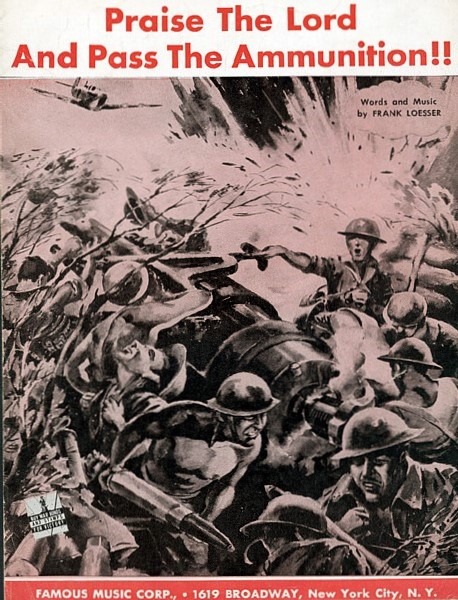By LCDR Sean Walsh, USN (Ret.)
Following up on last week’s commemoration of the 246th anniversary of the Chaplain Corps, the NHF would like to acknowledge the service of Navy chaplains during the attack at Pearl Harbor.
At the time of Pearl Harbor, the Chaplain Corps had only 192 chaplains on active duty (105 Regular and 87 Reserve) although actions were underway for the accession of additional Reserve chaplains. Of these, 19 were present at Pearl Harbor on December 7th, ranging in rank from Captain to Acting Chaplain (Lieutenant Junior Grade equivalent). 14 were assigned to ships, with the Fleet Chaplain having an office ashore although also assigned to the flagship USS California and the remaining four at various shore installations under the auspices of the 14th Naval District. There were eleven Protestant chaplains, seven Catholic and one Jewish.
At the time of the attack, several of the chaplains were preparing to conduct Sunday services and thought the attack was a drill being held at an inappropriate time. The explosions and identification of the planes as Japanese quickly dispelled that notion. Two chaplains were killed during the attack. Thomas L. Kirkpatrick on the Arizona is believed to have been killed instantaneously while Aloysius Schmitt who had been hearing Confessions on the Oklahoma survived the initial attack but died in a flooding compartment while helping other crew members escape through a porthole. For this action he was initially awarded the Navy and Marine Corps medal which was upgraded to a Silver Star in 2017 after his initially unidentified remains were positively identified using DNA from relatives. Two destroyer escorts, USS Kirkpatrick (DE‑318) and USS Schmitt (DE‑676) were named in their honor. They were the second and third Navy chaplains to have been killed in combat, the first being John L. Leinhart during the Civil War when the USS Cumberland was sunk by the Merrimac.
The chaplains aboard ship aided and comforted the wounded and dying and also assisted with their evacuation ashore. Chaplain Raymond Hohenstein on the USS California was himself wounded and for a while the rumor spread that he had died but fortunately that was not true. As a side note, he has the distinction of being the only Navy chaplain present both at Pearl Harbor and in Tokyo Bay at the time of the Japanese surrender. He also left an extensive oral history in 1983 about his career and experiences in the Navy. From this oral history it is clear that the chaplains had a great sense of community and supported each other, no matter what denomination they came from.
On the heavy cruiser USS New Orleans, Chaplain Howell Forgy encouraged the crew who were manually handling 5” shells to “praise the Lord and pass the ammunition” which became a popular song although the accompanying illustration incorrectly showed him manning a gun which as a noncombatant he could not do.
Two senior chaplains had previous combat experience during WWI and did not shrink from putting themselves in danger. Fleet Chaplain William Maguire had previously received the Navy Cross as a young man. He was waiting to go to the California to say Mass, but when the Japanese attack began he took charge of a motor whaleboat and helped transfer wounded ashore until the boat grounded, at which point he ministered to the wounded and dying ashore. Stanton Salisbury, assigned to the Pennsylvania, had been an Army chaplain during WWI and was ashore at the time of the attack. He picked up other officers and while driving to the ship survived strafing by a Japanese plane. After boarding the Pennsylvania, he ministered to those in need, then later went ashore to provide family members with news of their loved ones.
The hospital ship USS Solace sustained many casualties. The assigned chaplain, Charles Chrisman, cared for the wounded and dying, aided by Chaplain Raymond Drinan from the USS Nevada, who was onboard to say Mass, and later Chaplain Daniel Reardon, from the seaplane tender Tangiers.
Ashore, the 14th District chaplain, Thornton Miller, went to the Pearl Harbor Naval Hospital to join the assigned chaplain, Thomas Odlum, and minister to those in need. H. Cerf Straus, also assigned as a 14th District chaplain, remained behind to helped convert an unfinished building into a makeshift hospital and minister there.
Immediately after the attack, the District Chaplain’s office was turned into a temporary personnel office where survivors of the sunken ships were directed to report so that they could be accounted for and assigned to other duties. Chaplain Miller moved his office to the Army and Navy Y in Honolulu where he was more accessible to the dependents. He and his staff, with the aid of Navy Relief and volunteers aided in compiling a complete list of casualties, making family notifications for those living locally and responding to letters from stateside families seeking information about service members. They also assisted in making arrangements for the evacuation of dependent families to the mainland.
A final duty of the District Chaplain’s staff was funeral services for the many dead. Since many casualties were unidentified, these funerals were attended by a Protestant minister, a Catholic priest and Chaplain Straus, the only Jewish chaplain available.
Sources:
[1] The History of the Chaplain Corps, United States Navy, Volume Two, 1939-1949, Drury, Clifford Merrill, Bureau of Naval Personnel, Government Printing Office [2] Oral History Transcript, Captain Raymond Charles Hohenstein, Chaplain Corps, U.S. Navy (Retired), Oral History Program, Chaplain Corps, United States Navy, 1983 [3] The history of the Chaplain Corps, United States Navy, Vol. 3. United States Navy Chaplains 1778-1945, Drury, Clifford Merrill, Government Printing Office, 1948 [4] “Seventy-six years after he died at Pearl Harbor, a chaplain will get a combat medal”, Washington Post, December 6, 2017

